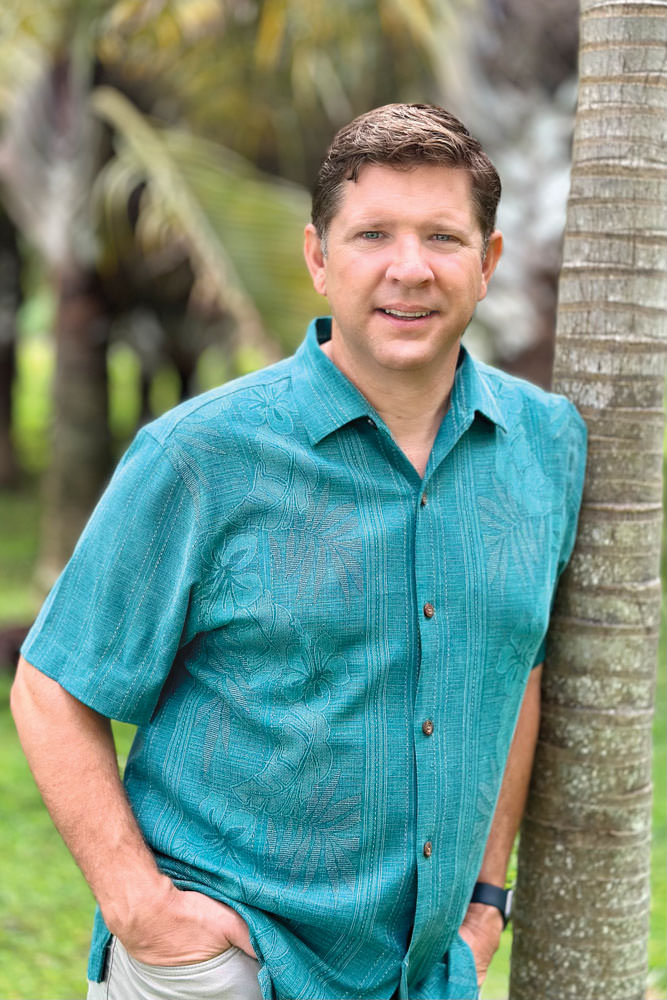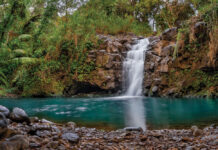Mauka to Makai

My mornings start mauka to makai.
I strap on my helmet, turn on my high-intensity headlight and check the tire pressure on my mountain bike.
With safety steps complete, I pedal up an incline through a former macadamia nut plantation then pause briefly at the intersection to look down on Paukkalo, Kahului Harbor, Kahului Airport and the North Shore.
In the winter, I can hear the waves pounding the reef at Ho‘okipa. In the summer, the surf is flat, and surfers are stalking placid south shore swells – but my exhilarating ride to work is about to begin.
I turn the corner, and with a few fast turns of the pedal, I’m on my way down the mountain. Gravity is my friend. I pick up speed. Roosters grazing for bugs on the roadside scurry away with heads ducked as a I fly past.
A few minutes later and I’m at the Kahekili Highway, then soon coasting into Happy Valley behind a Maui-style “traffic jam” of four or five Tacoma work trucks. I stop at Takamiya Market for Spam musubi to-go, then ride over Wailuku River, then turn down Mill Street on the home stretch to the magazine’s office on Imi Kala Street.
But before I round the corner to the office – each morning I pass the same mural: “Mauka to Makai.”
Completed in 2019 as part of the Small Town, Big Art initiative, this painting by husband-and-wife team Matthew and Roxanne Ortiz shows a whimsical scene of a tree house with a yellow playground slide and half-pipe skateboard ramp. But its message is all-business.
The builders of the tree house have repurposed two voyaging canoe ama (outriggers) to be planters for a thriving aquaculture garden. A catchment tank provides water to a closed system that feeds a “Native Plant Nursery.”
In the distance is a verdant mountainside with a stream flowing to an ocean bay where an inset painting depicts coral teaming with reef fish and honu.
In Hawai‘i, we use the words “mauka” and “makai” frequently to give directions: A house, business or road toward the mountain is mauka; toward the ocean is makai. Put them together, “mauka to makai,” and we get a profound statement about the interconnectedness of the land and ocean.
Here on Maui, whether you recognize it or not, mauka to makai drives our daily life. We travel seamlessly between the two in our commutes for work and recreation. It drives our weather patterns, too – resulting in wind and rain that can be nourishing or destructive.
The ancient Hawaiians developed wisdom, tradition and practices based on the mauka-to-makai connection. “They learned to adapt to, steward and live in tandem with the environment,” Pukalani-based researcher Cody Pueo Pata told me.
This sacred mauka-to-makai relationship is consummated at our beaches – the place where land steps into the ocean. Phuehue (beach morning glory), which graces our magazine cover, has an important task on our beaches. Above ground, we see its purple flowers, goat’s feet-shaped leaves and network of creeping vines. But the real work happens subterranean. Each plant pushes down thick taproots and sends runners that connect and stabilize the fragile shoreline from the pounding forces of nature.
When beaches wash out and are reformed, phuehue is usually the first plant to emerge and get back to work stabilizing the sand.
The mauka-to-makai connection has been going on for time immemorial and continues without many of us recognizing it. Featured in this issue, Maui Ocean Center has developed a new educational tour that seeks to teach us about how entwined our land and oceans are on Maui.
Scores of individuals and organizations are working for the same goal: healthier land, healthier ocean. Like phuehue, as each sends down deeper roots and expands its positive influence, the ancient mauka-to-makai connection gets stronger every year.
Click here to subscribe to Maui Nō Ka ‘Oi Magazine





